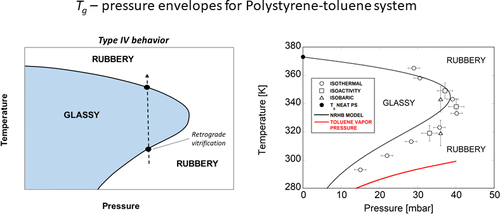当前位置:
X-MOL 学术
›
J. Phys. Chem. B
›
论文详情
Our official English website, www.x-mol.net, welcomes your feedback! (Note: you will need to create a separate account there.)
Modeling Retrograde Vitrification in the Polystyrene–Toluene System
The Journal of Physical Chemistry B ( IF 3.3 ) Pub Date : 2018-03-02 00:00:00 , DOI: 10.1021/acs.jpcb.8b01766 Giuseppe Scherillo 1 , Valerio Loianno 1 , Davide Pierleoni 2 , Rosario Esposito 1 , Antonio Brasiello 3 , Matteo Minelli 2 , Ferruccio Doghieri 2 , Giuseppe Mensitieri 1
The Journal of Physical Chemistry B ( IF 3.3 ) Pub Date : 2018-03-02 00:00:00 , DOI: 10.1021/acs.jpcb.8b01766 Giuseppe Scherillo 1 , Valerio Loianno 1 , Davide Pierleoni 2 , Rosario Esposito 1 , Antonio Brasiello 3 , Matteo Minelli 2 , Ferruccio Doghieri 2 , Giuseppe Mensitieri 1
Affiliation

|
Atactic polystyrene, as reported in a recent contribution by our group, displays a marked change in glass transition when exposed to toluene vapor due to plasticization associated with vapor sorption within the polymer. The dependence of the glass transition temperature of the polymer–penetrant mixture on the pressure of toluene vapor is characterized by the so-called “retrograde vitrification” phenomenon, in that, at a constant pressure, a rubber to glass transition occurs by increasing the temperature. In this contribution, we have used a theoretical approach, based on the nonrandom lattice fluid thermodynamic model for the polymer–toluene mixture, to predict the state of this system, i.e., rubbery or glassy, as a function of fluid pressure and system temperature. The experimentally detectable glass transition is assumed to be a kinetically affected evidence of an underlying II order thermodynamic transition of the polymer mixture. On the basis of this hypothesis, the Gibbs–Di Marzio criterion, stating that equilibrium configurational entropy is zeroed at the glass transition, has been applied to locate the transition. The working set of equations consists of the expression of configurational entropy obtained from the adopted lattice fluid model equated to zero, coupled with the equation expressing the phase equilibrium between the polymer phase and the pure toluene vapor phase in contact and with the equations of state for the two phases. Theoretical predictions are in good qualitative and quantitative agreement with the experimental results previously obtained gravimetrically performing “dynamic” sorption experiments, which represent a neat example of the occurrence of so-called “type IV” glass transition temperature vs pressure behavior. The peculiar retrograde vitrification phenomenon and the glass transition temperature vs pressure envelope determined experimentally are well described by the proposed theoretical approach.
中文翻译:

在聚苯乙烯-甲苯系统中模拟逆行玻璃化
正如我们小组最近的一份报告所报道的,无规立构聚苯乙烯在暴露于甲苯蒸汽中时,由于与聚合物内蒸汽吸收相关的增塑作用,在玻璃化转变方面显示出明显的变化。聚合物-渗透剂混合物的玻璃化转变温度与甲苯蒸气压力的相关性以所谓的“逆向玻璃化”现象为特征,因为在恒定压力下,温度升高会导致橡胶向玻璃化转变。在这一贡献中,我们基于聚合物-甲苯混合物的非随机晶格流体热力学模型,采用了一种理论方法来预测该体系的状态,即橡胶态或玻璃态,这是流体压力和系统温度的函数。假定实验上可检测到的玻璃化转变是聚合物混合物潜在的II级热力学转变的动力学影响证据。基于此假设,吉布斯–迪马齐奥(Gibbs–Di Marzio)判据表明平衡构型熵在玻璃化转变时为零,已被应用来定位转变。方程的工作集包括从采用的等于0的晶格流体模型中获得的构型熵表达式,表示聚合物相与接触的纯甲苯蒸气相之间的相平衡的方程以及状态方程。这两个阶段。理论预测与先前通过重量分析进行“动态”吸附实验获得的实验结果在质量和数量上吻合良好,这些实验代表了所谓的“ IV型”玻璃化转变温度与压力行为之间关系的清晰示例。所提出的理论方法很好地描述了实验确定的特殊逆行玻璃化现象以及玻璃化转变温度与压力包络线的关系。
更新日期:2018-03-02
中文翻译:

在聚苯乙烯-甲苯系统中模拟逆行玻璃化
正如我们小组最近的一份报告所报道的,无规立构聚苯乙烯在暴露于甲苯蒸汽中时,由于与聚合物内蒸汽吸收相关的增塑作用,在玻璃化转变方面显示出明显的变化。聚合物-渗透剂混合物的玻璃化转变温度与甲苯蒸气压力的相关性以所谓的“逆向玻璃化”现象为特征,因为在恒定压力下,温度升高会导致橡胶向玻璃化转变。在这一贡献中,我们基于聚合物-甲苯混合物的非随机晶格流体热力学模型,采用了一种理论方法来预测该体系的状态,即橡胶态或玻璃态,这是流体压力和系统温度的函数。假定实验上可检测到的玻璃化转变是聚合物混合物潜在的II级热力学转变的动力学影响证据。基于此假设,吉布斯–迪马齐奥(Gibbs–Di Marzio)判据表明平衡构型熵在玻璃化转变时为零,已被应用来定位转变。方程的工作集包括从采用的等于0的晶格流体模型中获得的构型熵表达式,表示聚合物相与接触的纯甲苯蒸气相之间的相平衡的方程以及状态方程。这两个阶段。理论预测与先前通过重量分析进行“动态”吸附实验获得的实验结果在质量和数量上吻合良好,这些实验代表了所谓的“ IV型”玻璃化转变温度与压力行为之间关系的清晰示例。所提出的理论方法很好地描述了实验确定的特殊逆行玻璃化现象以及玻璃化转变温度与压力包络线的关系。


























 京公网安备 11010802027423号
京公网安备 11010802027423号